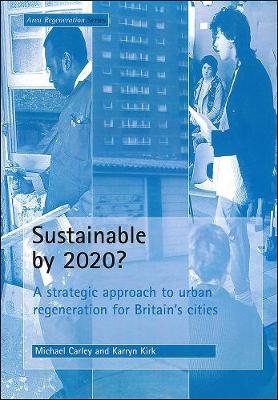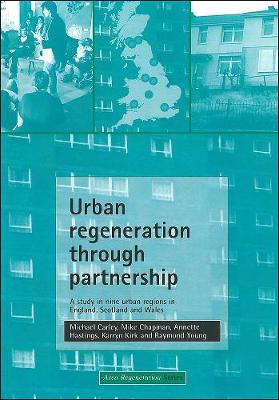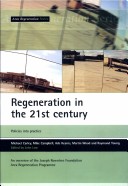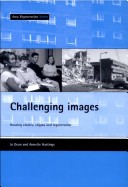Area Regeneration
7 total works
Thirty years of short-term initiatives have not reduced a pressing need for urban regeneration. If deprived households, polarised sink estates and derelict city landscapes are not to be with us 20 years hence, a broader, long-term approach is required.
Sustainable by 2020? describes this strategic approach to city-wide regeneration, developed in a major research programme with case studies in Birmingham, Manchester, Glasgow and Edinburgh. The report sets out an agenda of innovation as a first step to sustainable cities. It provides a better understanding of how cities can shift away from the piecemeal approach to build on steady, year-on-year achievement by improving our capabilities in urban management and participation.
Innovations suggested include:
underpinning regeneration with a 25-year national perspective on the future of our cities and countryside, with policies to match;
better integration between regional, city and local initiatives;
city strategies linking physical, economic and social development, urban regeneration and Agenda 21;
a life-long process of neighbourhood visioning as a right of all citizens, with participation beginning in primary school.
The authors stress that leadership, determination and imagination are required, with professionals, politicians and citizens working together to achieve the kind of communities we would like to leave to our children.
The report is essential reading for policy makers in national and local government, professionals and students, community representatives and everyone concerned with the future of Britain's cities.
Sustainable by 2020? describes this strategic approach to city-wide regeneration, developed in a major research programme with case studies in Birmingham, Manchester, Glasgow and Edinburgh. The report sets out an agenda of innovation as a first step to sustainable cities. It provides a better understanding of how cities can shift away from the piecemeal approach to build on steady, year-on-year achievement by improving our capabilities in urban management and participation.
Innovations suggested include:
underpinning regeneration with a 25-year national perspective on the future of our cities and countryside, with policies to match;
better integration between regional, city and local initiatives;
city strategies linking physical, economic and social development, urban regeneration and Agenda 21;
a life-long process of neighbourhood visioning as a right of all citizens, with participation beginning in primary school.
The authors stress that leadership, determination and imagination are required, with professionals, politicians and citizens working together to achieve the kind of communities we would like to leave to our children.
The report is essential reading for policy makers in national and local government, professionals and students, community representatives and everyone concerned with the future of Britain's cities.
Urban regeneration through partnership
by Michael Carley, Mike Chapman, Annette Hastings, Karryn Kirk, and Raymond Young
Published 17 May 2000
During the past 10 years 'partnership' has become a defining characteristic of British urban regeneration. It is widely recognised that the multiple problems of economic decline, social exclusion and dereliction require holistic and area-specific responses that can only be provided by effective multi-agency working, through local partnerships. Yet, to date, there has been little systematic research into why partnerships succeed or fail; into what works and what does not.
This report provides an in-depth study of the factors that influence the effectiveness of urban regeneration partnerships, and how they work within the emerging national policy context. Case studies were carried out in 27 partnerships in eight city-regions in England and Scotland and in the Welsh Valleys.
Urban regeneration through partnership highlights the key lessons of partnership, exploring good practice in:
· leadership;
· visioning and consensus building;
· translation of vision into workable objectives;
· including the community and business in partnership;
· human resources.
The report explores what it calls the 'foundations of partnership', including the modernisation of local government, a coherent regional development framework and a sound national urban policy. In addition, it provides detailed information on the case studies themselves, and gives good practice recommendations.
Urban regeneration through partnership is essential reading for workers and policy makers in urban regeneration partnerships, communities involved in urban regeneration and national and local government, as well as anyone with an interest in neighbourhood regeneration strategies and practice.
This report provides an in-depth study of the factors that influence the effectiveness of urban regeneration partnerships, and how they work within the emerging national policy context. Case studies were carried out in 27 partnerships in eight city-regions in England and Scotland and in the Welsh Valleys.
Urban regeneration through partnership highlights the key lessons of partnership, exploring good practice in:
· leadership;
· visioning and consensus building;
· translation of vision into workable objectives;
· including the community and business in partnership;
· human resources.
The report explores what it calls the 'foundations of partnership', including the modernisation of local government, a coherent regional development framework and a sound national urban policy. In addition, it provides detailed information on the case studies themselves, and gives good practice recommendations.
Urban regeneration through partnership is essential reading for workers and policy makers in urban regeneration partnerships, communities involved in urban regeneration and national and local government, as well as anyone with an interest in neighbourhood regeneration strategies and practice.
Including Young People in Urban Regeneration
by Suzanne Fitzpatrick, Annette Hastings, and Keith Kintrea
Published 3 September 1998
Regeneration in the 21st Century
by Michael Carley, Mike Campbell, Ade Kearns, Martin Wood, and Raymond Young
Published 12 December 2000
This report summarizes the findings of the whole of the Joseph Rowntree Foundation's Area Regeneration Programme. It provides an overview of knowledge to date and identifies the key challenges that we face in the 21st century. Analyzed by specialists in each field, these include: the impact of geography and reputation on regeneration; why community involvement is vital, and how it can be implemented; the effect of joblessness on regeneration, and how it can be mitigated; and why and how some partnerships succeed.
Is area and community regeneration enough to challenge the negative perceptions of a stigmatized housing estate? The authors of this report argue that, unless image problems are effectively challenged alongside regenration, stigma will remain. Providing detailed evidence from residents and others, the book: discusses the impact of stigma on residents' lives; pinpoints responsibility for negative estate images; suggests key factors for positively managing images; and provides good practice suggestions for "image management".




